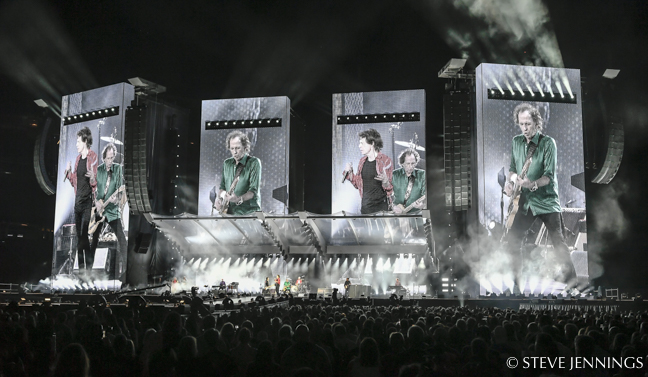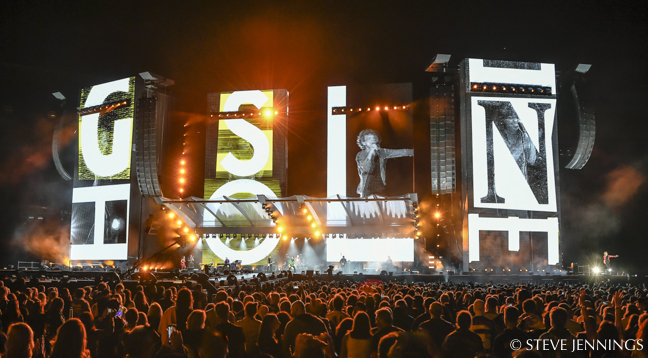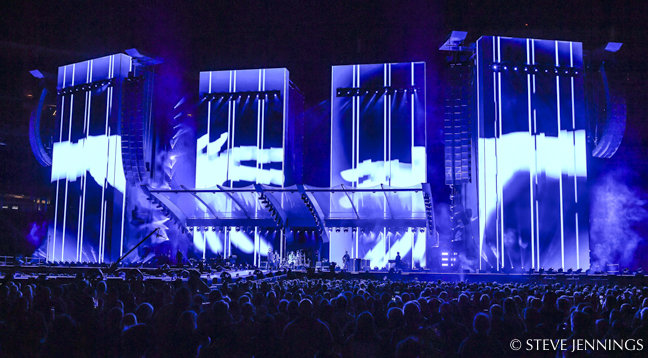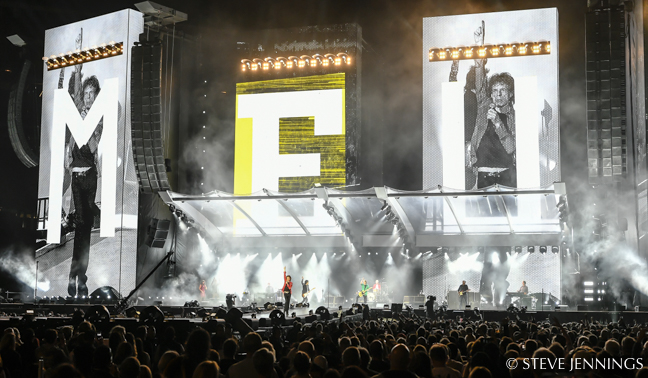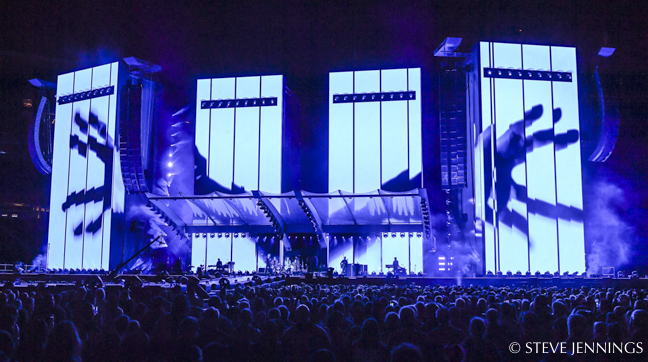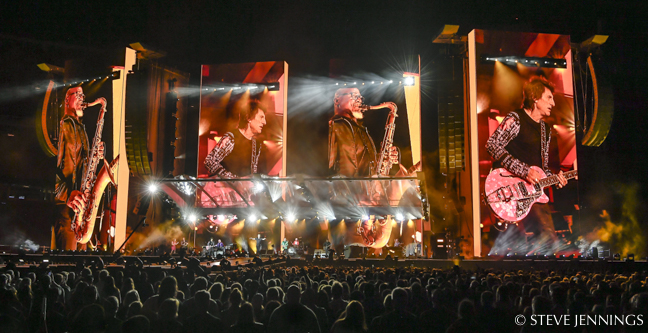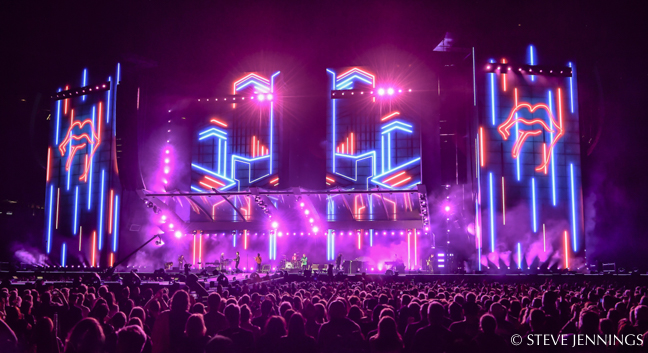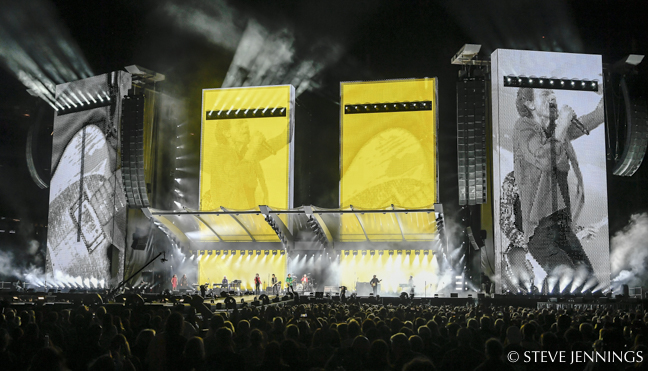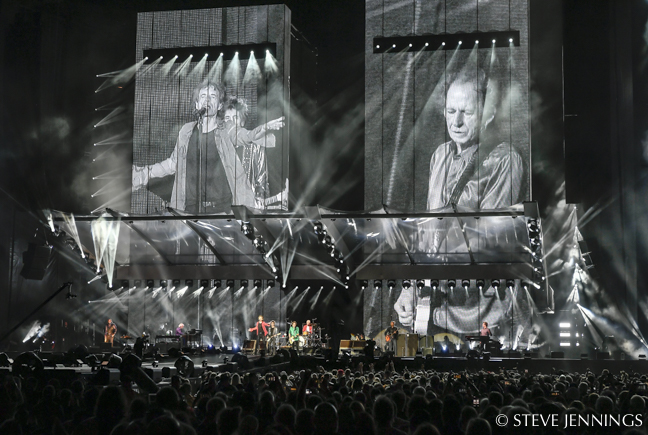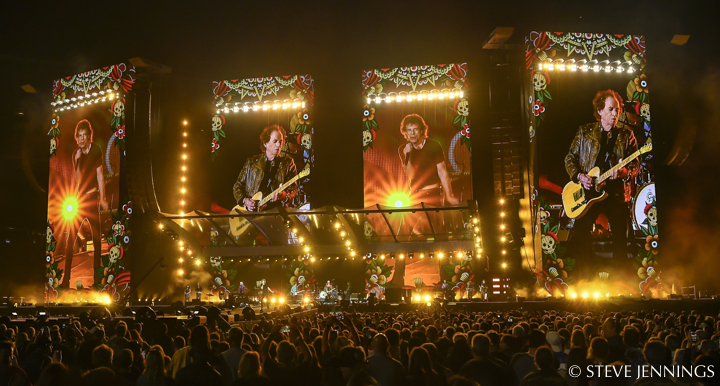
Design Team and Crew Bring “No Filter” Tour to North America
We checked out The Rolling Stones’ “No Filter Tour” on the very last week of the three-year trek, a date rescheduled after the tour was put on hold for Mick Jagger’s heart surgery, which was a total success. The band members were in top form, enjoying the night, with their smiles evident on the giant video screens. The set included numerous fan favorites — “Tumbling Dice,” “Honky Tonk Woman,” “Brown Sugar” and “Gimme Shelter,” to name just a few. We spoke with the creative team behind the tour — Patrick Woodroffe of Woodroffe Bassett Design, Ray Winkler of Stufish Entertainment Architects, lighting director/programmer Ethan Weber and video designer Roland Greil.
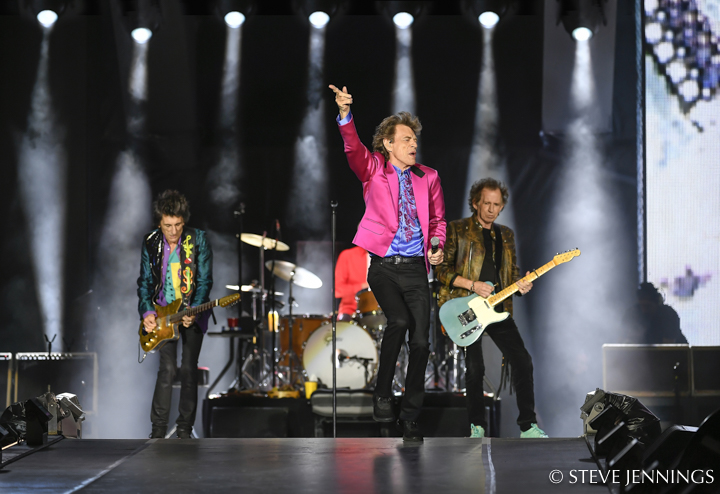
Patrick Woodroffe
Show Design and Creative Direction,
Woodroffe Bassett Design
Woodroffe notes that although the tours now are much shorter in length, typically 12 to 14 shows at a time rather the commitment to tour for 18 months, the standard and spectacle that the Stones’ audience expect cannot be any less impressive.
“The secret is to be judicious about how much custom fabrication there is in the design, and instead to use common parts in an imaginative way,” Woodroffe says. “For example, the four large portrait screens that dominate the stage are all made up of off-the-shelf equipment, but the video returns on their side edges involved a small amount of custom fabrication. The P.A. hangs in a traditional place, but the elegant brackets from which the stacks are flown were made specifically for the tour. The exception to this approach is the floating transparent roof that had to be made especially for the tour, but is essential as it gives rain protection to the musicians and their equipment, and then allows us perfect positions for the stage lighting.”
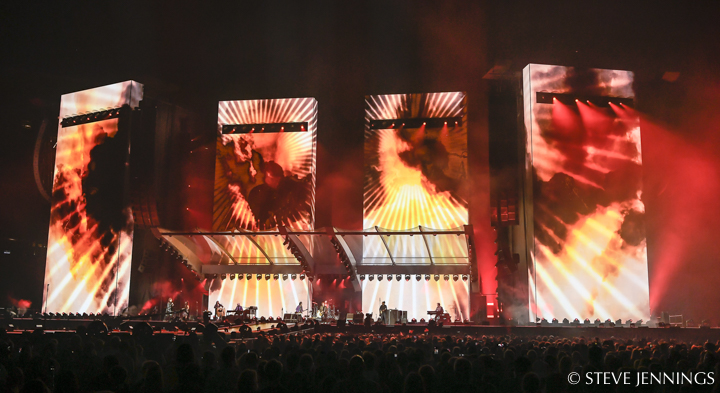
Woodroffe says that every project that he does always has a slightly different makeup in how the team is put together. Over many years working with the Rolling Stones, he and the band’s long-time lighting director, Ethan Weber, have collaborated extensively on the lighting, and Ethan not only runs the shows each night but also takes on the challenge of programming the songs. “The detail of the rig, the choice of fixtures, and the way the system is controlled involved a lot of coordination from Terry Cook, who also was responsible for the integration of the lighting with the other disciplines and in running the suppliers,” Woodroffe adds.
The “No Filter” tour design process started with the idea of four large portrait screens, and from that starting point, all other decisions flowed. The roof became low and transparent so that the central screens could be seen; the split PA stacks were positioned to hang off the outer screen; and so on. With the visual design finalized, Stufish Entertainment Architects then worked closely with Jeremy Lloyd from WonderWorks and, beyond that, with StageCo, WIcreations and production director Opie Skjerseth, to make the design practical, affordable and logistically possible. “The challenge at that point was to satisfy all these masters while retaining the design intent. This they did perfectly, and it is a great testament to Production that they understand Design, and vice-versa.”
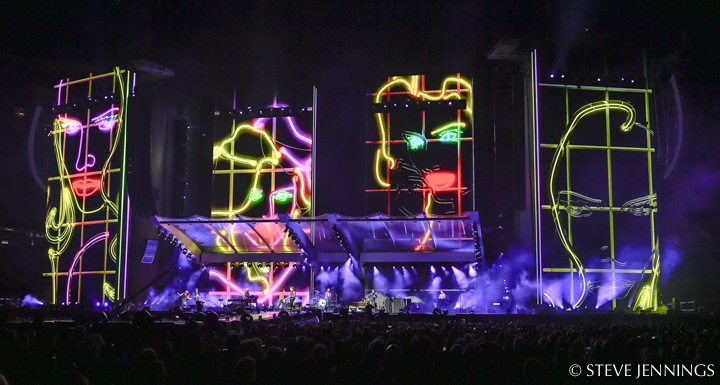
Woodroffe notes that, as unusual as it might sound, he cannot remember a time on any Rolling Stones tour when there has ever been a defined production budget. “There is always an absolute understanding that the show has to be the very best it can possibly be, and no corners are cut to achieve that. But at the same time, all of us who have the responsibility to deliver the show, have some sort of innate understanding of what is affordable and what is a step too far. We spend money, but rarely waste it.”
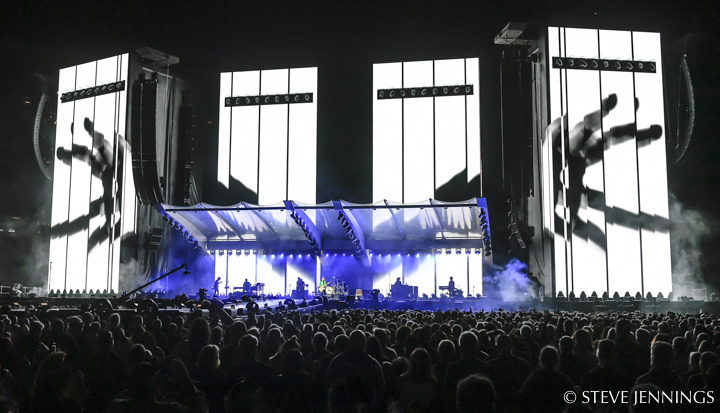
The Stones, Woodroffe explains, have always been about more than just their songs — who they are, how they look, what they represent, how they perform. These are all elements in the identity of The Rolling Stones. And, of course, their live shows are a large part of that. “The focus we’ve always tried to make in conceiving the way they are presented on stage is to provide spectacle, drama, excitement, surprise and humor, but always with a sense that it comes from the band. This is no less important in the use of the video screens. Playing straightforward I-Mag on all four screens throughout the show would ultimately become boring and would simply become a large-scale TV show. Alternatively, a subjective interpretation of each number would be indulgent and would frustrate our audiences, who often simply want to see the members of the group. Our game plan is therefore to carefully balance these two approaches and then add a third. So there is often simple I-Mag, but with a double cut from video director Nick Keiser, so we are not watching the same image on each screen. Then there are perhaps half a dozen numbers where we have commissioned pieces of film to enhance the message or emotion of the song — the fire and storm clouds in ‘Sympathy’ are an obvious example. And finally there is the idea of treated I-Mag. This is the same line cut from Nick, but with the images treated in some fashion. This could mean running a number in black and white, or perhaps sepia; or adding a color tint or a texture on a separate layer; or pixelating the image. All these effects change the look and feel of the stage completely, but never at the expense of not seeing the band. Finding this balance, and then running these choices as a series of live cues during a number, is beautifully executed by our image director Roland Greil, but in perfect synchronization with Ethan’s lighting.”
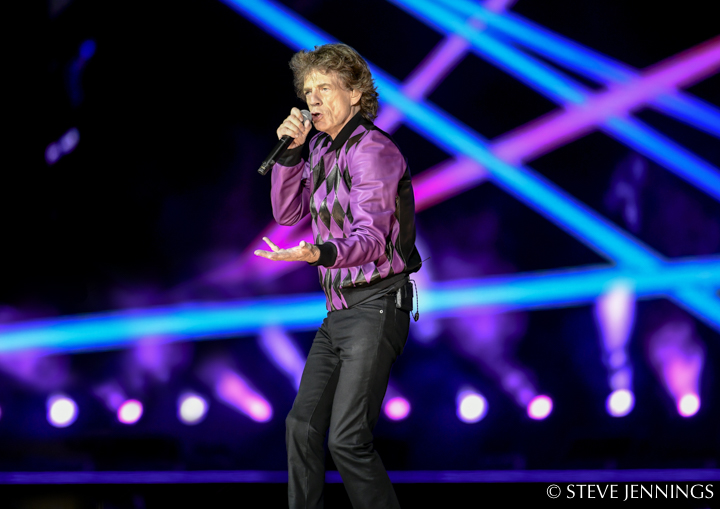
Woodroffe has worked with the Rolling Stones for more than 35 years. “That’s over half of my life,” he points out. “And it’s been an extraordinary privilege as well as a wonderful adventure. My role is to work with the band to conceive a show that is different each time they tour and that presents them in a different light, and then to leave them free to focus on their own performance. Helping to do this is a core team of people, all of whom know exactly what they are doing, and many of whom have worked with the band for a long time. Once we have an agreed concept for the show, my job is simply to stitch together all the production elements into a seamless whole and then keep the boat on an even keel. As with every successful creative team, whether it’s for a rock tour or a theatrical show, the secret is to have an experienced group of people with direct responsibility for their own disciplines, but who have the confidence to suggest and feed into the others. Where one part of the production begins and the next ends is difficult to discern and, of course, that’s the way it should be.”
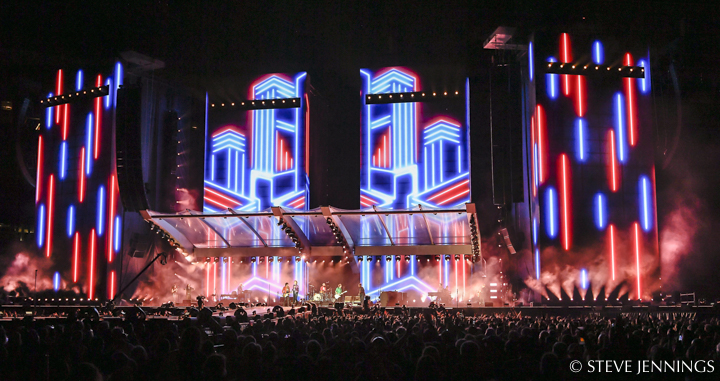
Ray Winkler
Stage Architect,
Stufish Entertainment Architects
Ray Winkler says that when you look back over the 30 years they have designed sets for the Rolling Stones, the diverse and eclectic array of different styles exuded exuberance. Starting with the Steel Wheels tour in 1989 right up to “Fourteen on Fire” in 2014, there was always an element of visual excess. “The ‘No Filter’ design is different,” Winkler notes. “In our very first conversations, it was clear to us that we needed to look at a fresh approach, something that broke the trend and went back to basics. Stripping down the design to its core components, we ended up with the four video monoliths that represented the four principals of the band, as well as the heroic cantilever roof. Cantilevering over 40 feet, and close to 80 feet in width, the roof is the pivotal design component that binds the vertical monoliths together and gives the band the vital weatherproofing home position without obscuring the screens behind them. This gives the design an architectural language that is very different from our previous designs.
“The challenge was to achieve this by essentially using the usual ingredients,” Winkler adds. “Rigging, lighting and P.A. details had to be re-thought, so Stufish worked very close with Opie (Skjerseth) the production manager and Jeremy Lloyd from WonderWorks to make sure that the design remained clean and crisp and achieved the essence of simplicity we all strived for. It was a great team to be part of, and this design is a great testament to this collaboration.”
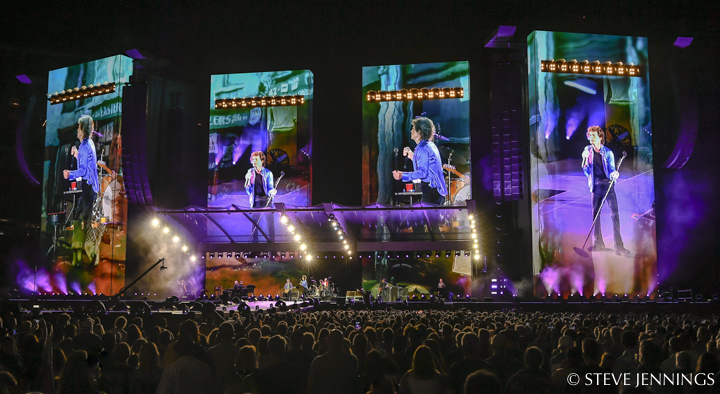
Winkler notes that the video monoliths broke the mold that a lot of touring LED screens are cast in. “Rather than the usual single 2D flat surface most tours now present their audiences with, we wanted something with a three-dimensional feel to it. We achieved this by giving the screens a five-foot-deep return on the edges, effectively turning them from 2D into 3D. This posed some interesting video content challenges. Treatment Studio responded very well to these challenges and delivered some very compelling and beautiful content. Solotech was very proactive in their desire to help us achieve this very clean 3D look for the video monoliths. Using their standard video tiles and frames, they came up with a great solution that achieved our objectives quickly and efficiently. The end result is a beautiful piece of technical detail design that delivers a compelling architectural silhouette.
“Stufish and Woodroffe Bassett Design have a great history together, and Patrick has been a longtime collaborator and friend,” Winkler continues. “Over the many years and many joint projects, we have developed a creative shorthand that fuses our respective contributions into interesting propositions. This was particularly apparent when it came to working together on the ‘No Filter’ tour.”
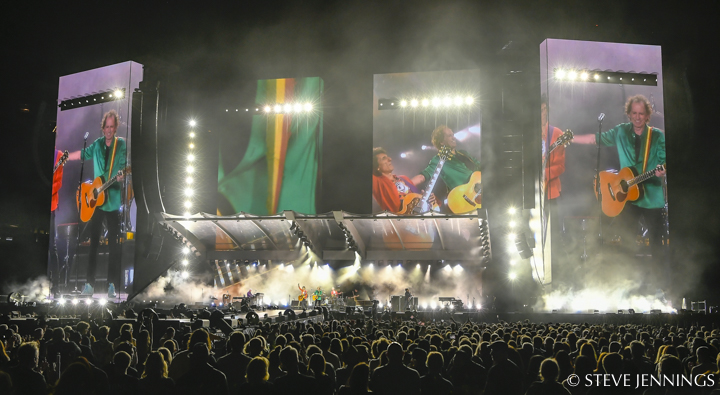
Ethan Weber
Lighting Programmer/Lighting Director
The “No Filter” tour started in Europe in 2017 and was a fairly big departure from the “Zip Code” (2015) and “America Latina Olé” (2016) tours, notes Ethan Weber. “The only really useful imports from past programming were the cue lists, which saved time typing, figuring out follow on cues, etc. I did keep a lot of the old classic looks — red on ‘Sympathy,’ big ‘Jumping Jack Flash’ sweeps… but starting almost from scratch allowed for a new take on the lighting.”
The U.S. run of “No Filter” (2019) was the third leg of the tour. The first two legs (in 2017 and 2018) were in Europe, so Neg Earth had built and crewed the tour twice already. To keep some consistency — an especially important consideration given all the custom pieces and very limited time for production rehearsals — production director Opie Skjerseth brought the main stage lighting and crew over from the U.K. Upstaging provided the front-of-house lighting spotlights and audience trusses. There were some minor changes between legs one, two and three, but more to do with fixture amounts and placements. Most of the fixture types remained the same.

“Our two main fixtures are the [Martin] MAC AirFXs and Robe BMFL’s,” Weber notes. “Most of the lower work is done with the AirFX, floors and under the roof. The BMFL’s are embedded in the top of the video walls, about 60 to 70 feet up. The original plan was to use the BMFL’s mainly in the audience, but once I started programming, I found them to be equally useful lighting the stage. The two sources worked well together — the BMFL’s are a little brighter than the AirFX, so a good choice for up top, and the AirFX have a smaller body, so less obtrusive down below. Both give off a very nice-looking beam, and I think they blended together well.”
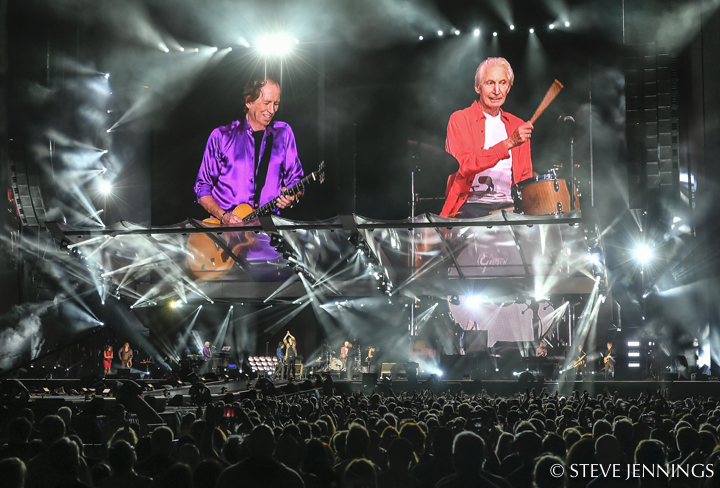
Once the overall scenic has been decided, Patrick Woodroffe and Terry Cook then work on fixture types and placements. Terry sends out an early version for opinions and suggestions. “I try to get in a week of previz to get basics in the console, a couple weeks with all or parts of the system at LH2/3, Upstaging or Tait, then another three or four days onsite,” Weber says. “The band will come in for two of those days, but show one is usually the first time we see them onstage in darkness. As far as the lighting process — Patrick will call early on and tell me what his overall idea is, then Terry usually sits with me for programming and we bounce ideas off each other while I push buttons. Patrick spends time at band rehearsals and with the video design team; so he’ll be in/out to give his blessing/offer suggestions with lighting. It’s all very collaborative and enjoyable.”
Like Woodroffe, Weber has been lighting this band for many years, and he echoes Woodroffe’s observations about the Rolling Stones’ evolving approach to touring, noting that the band’s touring model has changed significantly since the 2006/2007 Bigger Bang tour. Before that, tours were three to four years apart, running 12 to 18 months in length, and always worldwide, with three leap-frogging steel systems and crew and equipment that went everywhere. “Since ‘50 & Counting’ started in 2012, the tours have been shorter — usually two or two-and-a-half months, but more frequent — at least one leg per year — and they stick to one part of the world. Production-wise, we’ve all learned much from tour to tour, and things settle in much quicker. I think it was five months before we made it to bed before the sun rose on Voodoo Lounge in 1994. On ‘No Filter,’ it was a show or two in, and we were already loading in within five or six hours, and out within two-and-a-half.” Weber says he’s always very happily surprised when he gets the call to come back. “I never get tired of watching the band, lighting the show, working with everyone involved or take for granted how lucky I am to be there.”
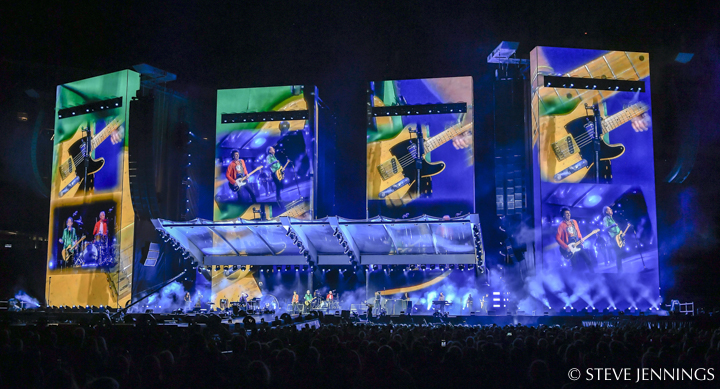
Roland Greil
Video Designer
Roland Greil says that working on any Stones show is special in its own right, as they’re quite iconic and there’s nothing else out there that really compares. “As always, it has been a great collaboration with Patrick [Woodroffe]. After having worked together on multiple projects for years, there’s a mutual understanding between the two of us. To be very like-minded helps as well to create something special together. After collaborating on Phil Collins and co designing Rammstein together, the Stones was the third project in a row. Coming back to this tour always feels a bit like coming home to your touring family, as this is such a fantastic camp of some of the finest people in our industry.”
Greil says that when they originally designed this tour in 2017, they wanted to create something contemporary and special. Four video screens, as there are four band members. “For many reasons, we also wanted to avoid a big television screen as far as possible and build something more architectural and three dimensional, which forms the perfect background for them to perform and keeps the focus on the band, while still being impressive. The whole process of creating this show was led by Patrick in his role of the creative director and lead designer. Again, a great amount of teamwork between all members of the creative team has been the perfect breeding ground to put this show together.”
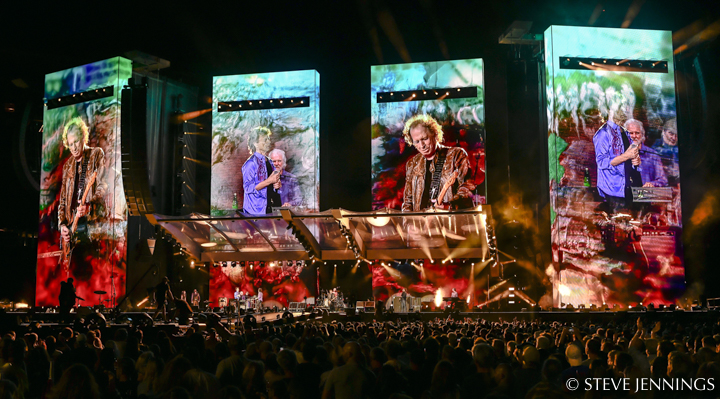
Video content producers Giles Maunsell (Lead) and Sam Pattinson and his team from Treatment Studio are working with Greil. “Again, a trusted and long-grown collaboration, as we have worked together on multiple projects,” Greil notes. “In the pre-production phase, Patrick showed the progress to the band, and discussed any changes using mood boards and previews. The original content was produced in 2017, but for the 2018 as well as 2019 legs, we changed things, added new pieces and updated parts to keep the show fresh.”
The main “brain” of the whole video playback system is a disguise/d3 setup, which is fully controlled from two grandMA2 Full size consoles (as main and backup). “The four different live feeds cut by my friend and talented camera director Nick Keiser are sent through the d3 as well, so we have full control of what is on the screens at any time. Furthermore, we use some Notch effects, also produced by Treatment, to treat and alienate the I-Mag feeds. Ultimately the live feeds are mixed with the footage. Everything happening in the d3’s is controlled from the grandMA’s. The whole show is run like a lighting show and is fully operated manually without any timecode or synchronization, which is key for success with the Stones, as they’re a live band true and true. In terms of servers, we’re using three disguise 4x4Pro’s; one as the main server, the second as a full backup, and the third as the master machine at FOH.”
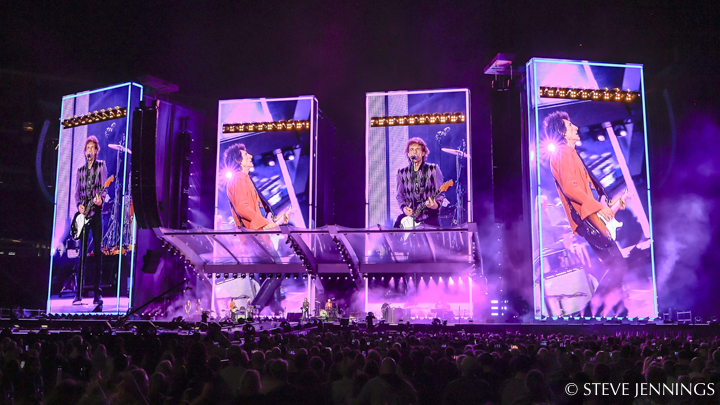
Greil notes that he and Woodroffe Bassett Design have worked with “No Filter” tour video vendor Solotech on other projects including Rammstein, Elton John and Ozzy Osbourne. All four screens are built with Saco S12 in Solotech touring frames. This specific product has a pixel pitch of 12mm. Every single screen has a resolution of 936 by 1,584 pixels, which results in an overall resolution of 3,744 by 1,584 pixels. “I’m proud to call most of their key people friends, and their support and gear is second to none,” Greil concludes. “A great video crew, led by my friend Ben Rader, makes my life easy.”
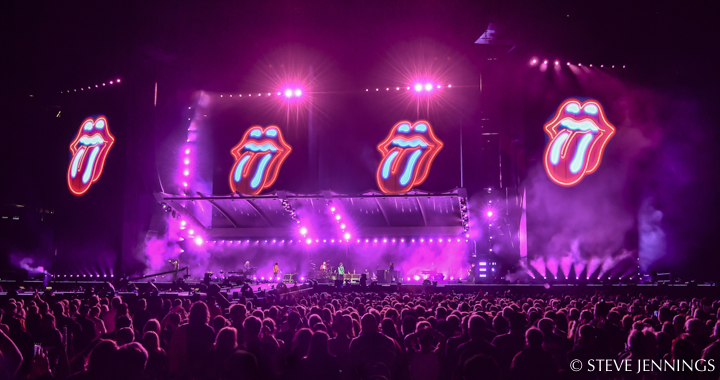
Title/Headline: The Rolling Stones “No Filter Tour”
2019 North American Leg
Crew
- Show Design & Creative Direction: Patrick Woodroffe/Woodroffe Bassett Design
- Stage Architect: Ray Winkler/Stufish Entertainment Architects
- Lighting Director & Programmer: Ethan Weber
- Video Designer: Roland Greil
- Associate Lighting Designer: Terry Cook
- Production Director: Dale “Opie” Skjerseth
- Tour Director: Paul Gongaware
- Production Coordinator: Lizzie Scace
- Production Assistant: Debbie Taylor
- Lighting Cos: Neg Earth, Upstaging
- Lighting Techs: Andrew “Fraggle” Porter (Head), Barry Branford, Damo Coad, William “Frosty” Frostman, Grant Hickey, Keith Johnson, Josh Larson, Tim Phillips, Nick Pishghadmian, Luke Radin, Gus Wimmer
- Video Content Producers: Giles Maunsell (Lead), Sam Pattinson
- Video Directors: Nick Keiser, Paul Becker
- Video Co: Solotech
- Video Engineer: Sebastien Lamoureux
- Server Tech: Yves Van Acker
- Video Techs: Ben Rader (Head), Thomas Cesano, Austin Colby, Mike Duque, John “Fuki” Fukushima, Bryan Keyes, Robbie Lawrence, Abe Main, Tim “Grape” Mattefe, Josh Phebus, Micah Wickre
- Road Manager: Ted Emporellis
- Stage Manager: Kurt Wagner
- Logistics Director: Richard Coble
- Tour Office: Sharon Ashley (Coordinator), Mike Meyer (Assistant)
- Media & Marketing: Cheryl Ceretti
- Staging Cos: StageCo, Tait
- StageCo Blue Steel Crew Chief: James Ramacus
- StageCo Red Steel Crew Chief: Jesse Winn
- Truss Structure: WICreations
- Riggers: Jez Craddick (Head), Antoin Patten, Elmer Vallejos
- Carpenters: Alex Blais (Head), Chris Davis, Freddy Hurtado, Jan Lehouck, Johnny Carra, Kurt Verhelle
- Trucking Co: Upstaging
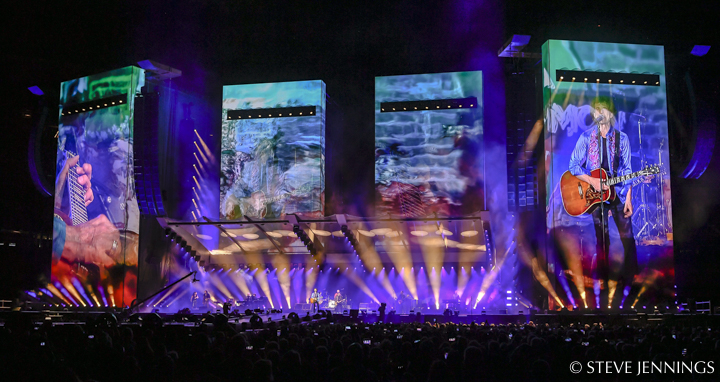
Gear
Lighting:
- 2 grandMA2 Full Lighting Consoles
- 1 grandMA2 Light Console
- 140 Martin MAC Viper AirFX
- 14 Martin MAC Aura XBs
- 36 Robe BMFL WashBeams
- 36 Vari-Lite VL3500 Washes
- 24 Claypaky Mythos
- 24 8-Lite Moles
- 36 Custom DWE Moles
- 72 SGM P-2 Custom White/CTO LED
- 18 SGM P-10’s
- 180 Meters of LED X-Flex
- 6 Hazebase Base Hazers
- 2 ZR44 Smoke Machines
- 12 Reel FX DF50s
- 8 Robert Juliat 4K Lancelots
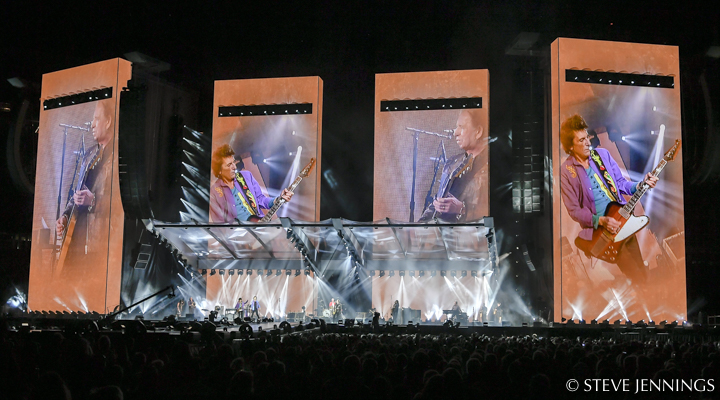
Video:
- 4 Stufish Video Monoliths
- 4 Monolith screens (12mm Saco S12 LED panels, 23 x 11 meters HxW, from Solotech)
- 2 disguise 4x4pro media servers
- 2 disguise 2x4pro media servers
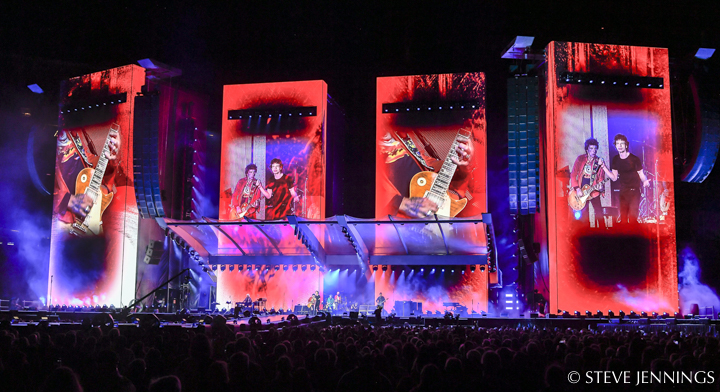
More 2019 Rolling Stones tour photos by Steve Jennings:
